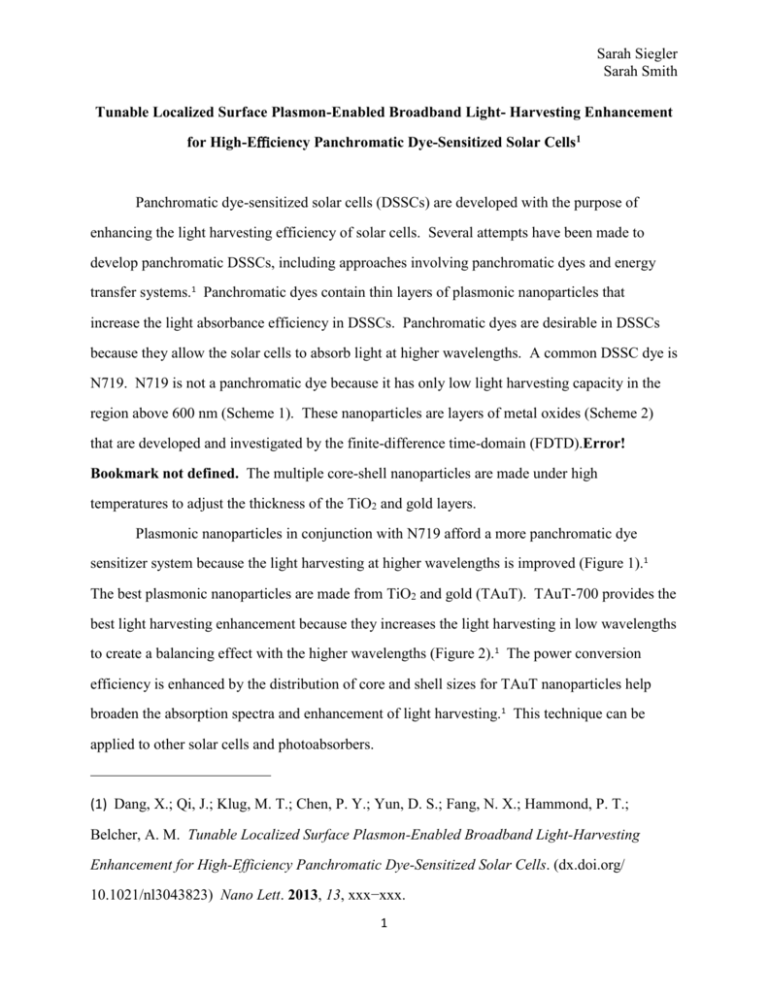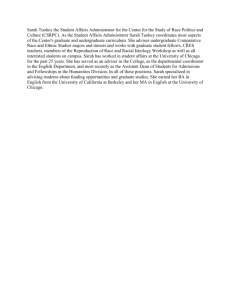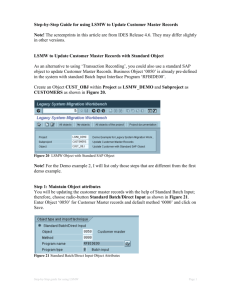DOCX
advertisement

Sarah Siegler Sarah Smith Tunable Localized Surface Plasmon-Enabled Broadband Light- Harvesting Enhancement for High-Efficiency Panchromatic Dye-Sensitized Solar Cells1 Panchromatic dye-sensitized solar cells (DSSCs) are developed with the purpose of enhancing the light harvesting efficiency of solar cells. Several attempts have been made to develop panchromatic DSSCs, including approaches involving panchromatic dyes and energy transfer systems.1 Panchromatic dyes contain thin layers of plasmonic nanoparticles that increase the light absorbance efficiency in DSSCs. Panchromatic dyes are desirable in DSSCs because they allow the solar cells to absorb light at higher wavelengths. A common DSSC dye is N719. N719 is not a panchromatic dye because it has only low light harvesting capacity in the region above 600 nm (Scheme 1). These nanoparticles are layers of metal oxides (Scheme 2) that are developed and investigated by the finite-difference time-domain (FDTD).Error! Bookmark not defined. The multiple core-shell nanoparticles are made under high temperatures to adjust the thickness of the TiO2 and gold layers. Plasmonic nanoparticles in conjunction with N719 afford a more panchromatic dye sensitizer system because the light harvesting at higher wavelengths is improved (Figure 1).1 The best plasmonic nanoparticles are made from TiO2 and gold (TAuT). TAuT-700 provides the best light harvesting enhancement because they increases the light harvesting in low wavelengths to create a balancing effect with the higher wavelengths (Figure 2).1 The power conversion efficiency is enhanced by the distribution of core and shell sizes for TAuT nanoparticles help broaden the absorption spectra and enhancement of light harvesting.1 This technique can be applied to other solar cells and photoabsorbers. (1) Dang, X.; Qi, J.; Klug, M. T.; Chen, P. Y.; Yun, D. S.; Fang, N. X.; Hammond, P. T.; Belcher, A. M. Tunable Localized Surface Plasmon-Enabled Broadband Light-Harvesting Enhancement for High-Efficiency Panchromatic Dye-Sensitized Solar Cells. (dx.doi.org/ 10.1021/nl3043823) Nano Lett. 2013, 13, xxx−xxx. 1 Sarah Siegler Sarah Smith Scheme 1. Structure of Dye N719 2 Sarah Siegler Sarah Smith Scheme 2. Structure of Plasmonic Nanoparticle TAuT-700 3 Sarah Siegler Sarah Smith Figure 1. Simulation of N719 Absorption Spectrum Gaussian Functions for N719 9 Extinction coefficient (M-1 cm-1) 8 Function 1 7 6 Function 2 5 4 Function 3 3 2 Sum of Gaussian Functions 1 0 -1 350 400 450 500 550 600 650 700 750 Wavelength (nm) 𝑓(𝑥) = 𝐻𝑒𝑖𝑔ℎ𝑡 ∗ Function 1 x = wavelength height = 5.25 max = 0.011 a = λmax, 390 nm −(𝑥−𝑎)2 1 1 𝑒 2𝜎2 𝑚𝑎𝑥𝑖𝑚𝑢𝑚 √2𝜋𝜎 2 Function 2 x = wavelength height = 2.00 max = 0.003 a = 450 nm 4 Function 3 x = wavelength height = 6.25 max = 0.009 a = 530 nm Sarah Siegler Sarah Smith Figure 2. Simulation of Absorption Spectra for AgT, N719, AuT, and TAuT Nanoparticles Absorbance (a.u.) Gaussian Functions for Nanoparticle Absorbance 14 13 12 11 10 9 8 7 6 5 4 3 2 1 0 AgT N719 AuT TAuT-590 TAuT-700 TAuT-810 350 450 550 650 750 850 950 1050 Wavelength (nm) 𝑓(𝑥) = 𝐻𝑒𝑖𝑔ℎ𝑡 ∗ −(𝑥−𝑎)2 1 1 𝑒 2𝜎2 𝑚𝑎𝑥𝑖𝑚𝑢𝑚 √2𝜋𝜎 2 x=wavelength a=λmax 5







